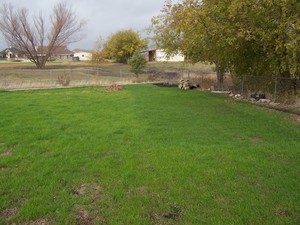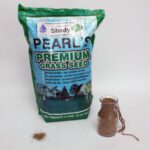Annual Rye can be used as a winter grass, a cover crop or as erosion control.
Annual Rye grass can be used in a variety of ways that are all beneficial to your lawn, your garden or for erosion control on your property. Listed below are the methods you can use to receive the best benefits from an annual rye grass application.
Using Annual Rye for over seeding your warm season turf grass:
September is the best month, typically at the beginning of the month, to make this application to your current turf grass. Scalp your turf to one inch high and remove all of the clippings. If you’d like to aerate your lawn area, now would be a good time.
Aerate and then apply a high root stimulating fertilizer. This will support the roots of your warm season grass through the winter and also help the annual rye to get established. Then, spread the rye grass seed to approximately 10 pounds of seed to every 1,000 square feet of turf area. This is a heavy application, but you should be guaranteed a great stand of grass during the winter months.
Once the new seedlings reach 3-4 inches tall, make a slight mowing of no more than one inch. Maintain your new winter lawn at 3-4 inches tall. Fertilize with a 21-0-0 fertilizer at this time, and only apply this same fertilizer more than once during the season if you live in a warmer climate.
Using Annual Rye Grass as a Cover Crop in your vegetable garden.
Many gardening USDA Zones are unable to garden through the winter. This is a good opportunity to over seed your entire garden area with annual rye as a cover crop. This over seeding will not only provide your soil with great fodder for you to turn under in the Springtime, but will also act as erosion control to help you to avoid losing precious compost during heavy winter rains in your region. Annual rye is well known for providing the soil additional structure and tilth to your soil.
Scratch up the soil surface before spreading the seed. Remove any debris that will interfere with seedling growth. Spread a quality seed starting fertilizer prior to spreading seed. Evenly apply at least 5 pounds of annual rye seed per 1,000 square feet of vegetable garden. Tamp the seeded area for good contact with the soil. Water in well, and then water once daily unless there is rain in your local weather forecast. The seed should germinate within 7 days. Leave untended throughout the entire winter.
Turn the rye grass under when your soil is workable in the spring. Plan to let your freshly turned soil sit for at least two weeks prior to planting your vegetable seeds and transplants. You may need to turn, or rototill, your soil once more depending on how well the cover crop decomposed.
Using Annual Rye Grass as Erosion Control.
Annual rye grass is often used for erosion control on disturbed soil. Applications should be made a little on the heavy side to make sure you get a good stand of grass to cover the soil well and avoid tearing soil out in heavy rains where a lot of water moves across this disturbed area.
Scratch soil area with a rake and remove large stones and other debris. Apply a seed starting fertilizer at rates according to the fertilizer label. Spread annual rye grass seed at a rate of at least 8-10 pounds per 1,000 square feet. Water in well and then water once per day unless you are receiving local rain. Seed will normally germinate within 7 days. DO NOT MOW AT ALL during the winter. You need to let the grass grow as long (length) as it can to provide as much cover as possible, especially if you have a lot of water movement on your property.
There are several photos accompanying this article. Please click on the photos to see an enlarged view.
Source: Steven Coyne’s property and the “Gardeners Guide” Blog.







